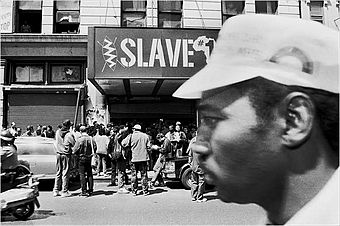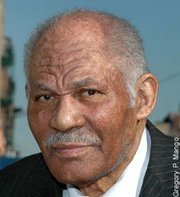Slave Theater facts for kids
|
Slave I
|
|

Street view of the Slave Theater marquee, before the theater was demolished in 2016
|
|
| Former names | Regent Theater |
|---|---|
| Address | 1215 Fulton Street |
| Location | Brooklyn, New York 111216 |
| Coordinates | 40°40′50″N 73°57′10″W / 40.680677°N 73.952772°W |
| Type | Movie theater |
| Construction | |
| Built | 1910 |
| Opened | 1986 |
| Closed | 2012 |
| Demolished | 2016 |
The Slave Theater, also called Slave I, was a movie theater in Brooklyn, New York City. It was located on Fulton Street in the Bedford–Stuyvesant area. A Brooklyn judge named John Phillips started the theater in 1984. He wanted to show a film he had made. The theater soon became an important place for civil rights activities in Brooklyn.
Judge Phillips chose the name "Slave Theater" to remind people of slavery. He wanted to highlight its role in African-American history. Not everyone in the community liked the name. However, the theater became a symbol of Black pride in Brooklyn. After Judge Phillips passed away, there was a long legal fight over who owned the theater. It was finally sold in 2013 and torn down in late 2016.
Contents
History of the Slave Theater
How the Theater Started
In 1984, Judge John Phillips, a judge from Brooklyn, bought the Regent Theater. This theater was built in 1910. Judge Phillips had made a movie called Hands Across Two Continents. He could not find other theaters to show his film. So, he bought two theaters in Brooklyn to play it. He renamed the Regent Theater the Slave Theater. He wanted the name to remind everyone where they came from.
A Center for Civil Rights
In the late 1980s, Judge Phillips opened the Slave Theater as a safe place for the local Black community. It became a hub for civil rights work. Famous civil rights leader Al Sharpton began holding weekly meetings there. He said these meetings helped increase civil rights organizing in Brooklyn. For example, the Slave Theater was a meeting point for marches and speeches. These events happened after a tragic event in August 1989.
Challenges and Closure
Judge Phillips became unwell in 2001 and passed away in 2008. He did not have a will, so the theater was left without money or a clear owner. The building started to fall apart. In 2012, the city ordered it to be emptied. This happened after a patio collapsed during a party, hurting four people.
A local group called the New Brooklyn Theatre tried to buy the theater. They started a Kickstarter campaign to raise money in 2012. The theater's manager, Clarence Hardy, and his son Omar also said they owned the building. Clarence had lived there for years with Judge Phillips's permission. The Hardy family claimed Judge Phillips had given them ownership in 1999.
Legal Battles and Demolition
A judge decided that Judge Phillips was not in a clear state of mind when he supposedly gave the property to the Hardys. So, ownership went to Phillips's nephew, Rev. Samuel L. Boykin. Boykin planned to have the Hardys and a church living there leave the building.
In August 2013, Boykin sold the theater to the Fulton Halsey Development Group for $2.1 million. This happened before the Hardys' appeal was finished. Clarence Hardy tried to save the theater. He protested by standing on its roof. Other activists also protested the theater's destruction. They were against gentrification. Despite these efforts, the Slave Theater was torn down in December 2016. The new owner, Industrie Capital Partners, planned to build new homes and shops there.
In 2019, a company from London called The Collective bought the land where the theater stood. They bought it and other nearby lots for $32.5 million. The Collective has said they are planning a way to remember the history of the Slave Theater in their new development.
Architecture and Design
Exterior Look
The biggest change Judge Phillips made to the outside of the theater was adding its famous black-and-white sign. This sign was called the Slave Theater marquee.
Interior Murals
Inside the theater, Judge Phillips had artists paint murals on the walls. These murals showed heroes from Black history. Some of the heroes included Toussaint Louverture, Marcus Garvey, and Malcolm X. There was also a mural of Bruce Lee.


